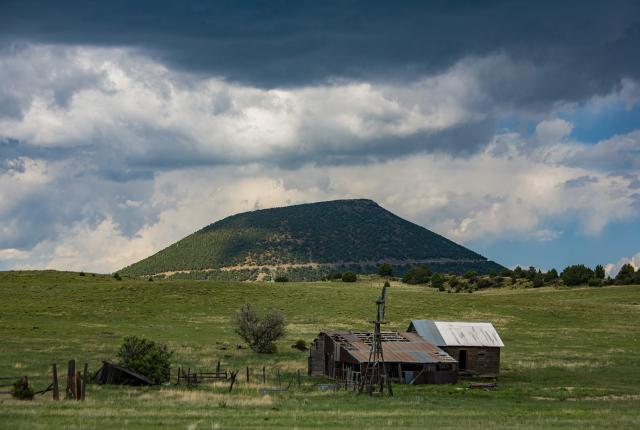The Route
Summer is an ideal time to follow this scenic high-country route through old mining and ranch towns, volcano fields, and outdoor hot spots. From Ratón, NM 72 climbs to Johnson Mesa, then drops into the Dry Cimarron River Valley at Folsom. The grassy plains between Folsom and Clayton hold extinct volcanoes. And with elevations ranging from 5,000 feet to nearly 9,000 feet, the days are cool and pleasant.
Day 1
Rise early in Ratón for a breakfast burrito at 111 Park Espresso Bar. (You’ll find few choices for food along today’s route, so buy a couple of cold roast-beef-and-green-chile wraps for later.) Before hitting the road, visit the Ratón Museum. Located in the historic First National Bank of Trinidad building, it features items including New Mexico’s first (1913) license plate, Native baskets, and paintings by New Mexico artists.
Head east on NM 72 through a grassy valley before turning into the broad canyon of Chicorica Creek. The road winds out of the east fork onto Johnson Mesa, a 14-mile plateau of thick grassland sprinkled with a few ranches and abandoned homestead sites. Views of the Sangre de Cristo Mountains open to the west, with Colorado to the north. In the middle of the mesa, the small Johnson Mesa Church endures alone. Once a year, residents gather there for a Sunday service.
After passing the church, you’ll see several volcanoes to the south and east. The road descends through groves of ponderosa pine, locust, and scrub oak into the valley of the Dry Cimarrón River. A historic marker describes the nearby archaeological site where a local discovered the first evidence of what became known as Folsom Man.
On August 27, 1908, a raging Dry Cimarrón River killed 17 people and destroyed much of Folsom. It caused heavy erosion, and George McJunkin, foreman of the Crowfoot Ranch, discovered large bones in the walls of an arroyo, which he correctly determined were from a long-extinct bison. In 1927, a spearpoint was found lodged in the earth between two bison ribs, overturning long-held beliefs about when humans first arrived in America. The Folsom Museum features displays on McJunkin, Folsom Man, and more local history. Located in the former Doherty Mercantile building, the museum hosts an open house on June 11, guided tours of Johnson Mesa on July 9, and tours of the Folsom Man site on May 21 and August 20. (Tour reservations are required.)
South of town, the highway crosses the Ratón-Clayton Volcanic Field. Several of the volcanoes, including Capulín, Twin Mountain, and Baby Capulín, formed relatively recently, roughly 50,000 years ago.
At the Capulín Volcano National Monument, a narrow, paved road climbs to the star of the show’s summit. The one-mile Crater Rim Trail delivers spectacular views of volcanoes dotting the grassy plains, while the paved Crater Vent Trail leads to the bottom of the crater. Before you go, trek the one-mile Lava Flow Trail loop, at the volcano base, for great views of the surrounding landscape.
Continue south to Capulín, an area of dryland wheat and bean production before the Dust Bowl of the 1930s shuttered most farms. As you head east on busy US 64/87, you’ll pass 8,720-foot Sierra Grande, the area’s tallest volcano, before rolling into Clayton. Grab a burger at the 87 Restaurant or a more elaborate meal at the Hotel Eklund before you settle in.
Add a Day
For a serious splurge, consider a night or two at Vermejo, a Ted Turner Reserve, Ted Turner’s 550,000-acre property west of Ratón. Guests can enjoy the spa, 19 fishable lakes, horseback riding, mountain biking, and more. Commonly seen wildlife includes elk, bison, and bears. The summer cookouts go way beyond normal fireside fare.
Day 2
Hit Mock’s Crossroads Coffee Mill for biscuits and gravy and a fresh-roasted brew or a fruit smoothie. Gather picnic fixings at Clayton Ranch Market and head on to Clayton Lake State Park and Dinosaur Trackways, where the kids will enjoy seeing hundreds of dinosaur footprints near the dam, hiking the 1.4-mile interpretive nature trail, kayaking on the no-wake lake, and stargazing at the Lake Observatory.
From the state park, return to Clayton and the Herzstein Memorial Museum. The eclectic museum, named for the Jewish pioneers who owned the 1896 general store, features exhibits on subjects ranging from the Santa Fe Trail to New Deal art and furniture, plus antique dolls. Outlaw “Black Jack” Ketchum, hanged in Clayton in 1901 for robbing a train near Folsom, even has his own room. Make like a bandit yourself: Follow the trains on the main line, paralleling US 64/87, back to Ratón.
Family Zone
At Sugarite Canyon State Park, Lake Alice and Lake Maloya offer fishing and no-wake boating. Nearly 13 miles of hiking and biking trails wind through what was once a coal-mining community. An interpretive trail starting across from the park office leads through the ruins and abandoned mines of the old Sugarite coal camp. Most of the town’s buildings are long gone, having been salvaged or destroyed by time, leaving little more than foundations and memories.
Where to Stay
Bed down at the 24-room Hotel Eklund for restored old-fashioned charm. Built in 1892 as a saloon and gambling hall, the property was bought by Carl Eklund in 1894 and slowly expanded to become the current three-story hotel with a spirited past (and a few spirits who may still linger).
If camping is your thing, reserve a site at Clayton Lake State Park, where 26 developed campsites, some with partial hookups, are tucked in rolling grasslands above the park lake, at 5,200 feet.







